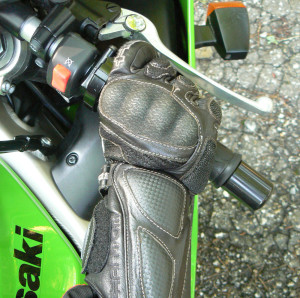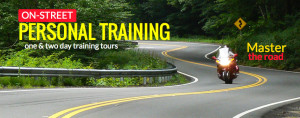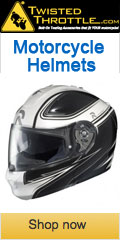This is number 3 in a series on adapting to a new motorcycle, whether that means borrowing a friend’s bike, swapping bikes on a ride, or adapting to a new bike. Please share your experiences in the comments section. If you’d like, read Part 1 and Part 2 to see what other challenges we often face when adapting to a new motorcycle.
You Can’t Handle all that Power
Testing the brakes is probably the first thing you should do when swinging a leg over a new bike. Many people think that power delivery is the most important thing to calibrate to, because acceleration is a more obvious and intimidating force…fewer people seem intimidated by brakes. Even though more people seem to get into trouble with unfamiliar brakes, plenty of people fail to consider what they’re in for when twisting the throttle.
Throttle Transitions
One of the most common issues I have when riding different bikes is how smooth or abrupt the power delivery is when transitioning from off-to-on throttle. This can be a serious control issue if I am at full lean. When I crack the throttle, I am looking for a smooth delivery of power. But, some bikes are not mapped (FI bikes) or jetted (carbureted bikes) correctly for a gradual, controlled transition. What I get instead is a lurch that upsets the tires and sends the bike off line. One of the worst bikes I’ve ridden was an early model Honda RC51. It took all my tricks to control that bike’s fueling (see below).
I had my mind set on buying a new Yamaha FZ-09, but after hearing about the abrupt throttle delivery, I decided on the Street Triple, which is know for decent throttle control and response. Although it could be better, IMO.
Manufacturers try to find the balance between meeting emissions requirements and acceptable performance, which means that the fueling is often too lean for good throttle control. This is where Power Commanders and other aftermarket products come in. With a little time and a laptop, you can adjust the fueling the way it should be for performance, at the expense of emissions…something the manufacturers aren’t allowed to do.
photo: www.owenstrackdayphotos.com
Throttle Response
Throttle response is another factor that varies from bike to bike. Throttle response is how quickly the engine responds to rider throttle inputs. A snappy response is good for sportbike riders that want immediate results to get the bike launched as hard as possible. This is especially desirable when riding on the racetrack. Many racers install quick-turn throttle housings to get to full throttle with as little wrist movement as possible.
Street riders usually want a less aggressive throttle response so that inadvertent throttle movements don’t result in unwanted acceleration. But, slow throttle response can make a bike feel sluggish, unexciting and lazy.
Managing All That Power
To get a feel for throttle response and power delivery, find a straight section of road and roll on the throttle gradually. Grabbing a handful of throttle grip could land you on your ass if the rear tire spins or if you loop it in a mondo wheelie. In either case, you now own a bike that some idiot crashed (you).
If you are testing a bike with multiple power delivery modes, you may want to set it to the “rain” mode to soften power delivery. After some time, you can try the full power modes. Apparently, the FZ-09 has acceptable throttle transitions using the least aggressive power mode, but what fun is that?
Throttle Tricks to Try
Here are some simple things to do to help manage throttle control:
- Ratchet Throttle- Instead of rolling the throttle like a rheostat, move your wrist as though you are rotating through a series of “clicks”. This measures your throttle position better to help resist introducing too much throttle at one time.
- Keep your wrist down- A comfortable wrist-down position “locks” your throttle in position and helps control throttle movements.
- Relax- Arm tension transfers to the handlebars and handgrips.
- Anchor your thumb- Stick your thumb out a bit to make contact with the handlebar control pod to lock your hand in place. This is especially useful when riding at slow speeds.
What experiences have you had with throttle characteristics on different bikes?
Part 1 can be found Here.
Part 2 can be found Here.
Please subscribe to my Newsletter Mailing List
Please Donate to Keep the Articles Coming
If you liked this article and the many other articles on this site, please toss a buck or five into the hat. It’s greatly appreciated!
- Click the PayPal “Pay Now” button.
- Then indicate quantity in $2.00 increments. – Example: put “2” in “QUANTITY” field to donate $4.00, “3” for a $6.00 donation, etc.
Why $2.00? Due to the PayPal fee structure, a $2.00 donation is significantly more beneficial compared to a $1.00 donation.
Thank You!
Check out these posts:
- Product Review: TCX X-Desert Boots
- Get Anxiety & Stress Under Control (Motorcyclist)
- KLX250s Upgraded and Accessorized
- Street Triple R Gets Accessorized
- Triumph Street Triple R Review
- How To Survive Mid-Corner Hazards
- #1 Reason for Motorcycle Crashes in Corners
How Can I help You? Online Coaching NOW AVAILABLE
Stay Informed: Subscribe NOW!
 Be a Better Rider: Sign Up for Personal Training with Ken
Be a Better Rider: Sign Up for Personal Training with Ken
Support Riding in the Zone: Buy a book
Support Riding in the Zone: Buy products from Twisted Throttle & Amazon









Ken
Back in March of this year I crashed at Jennings GP in Fla. After reading your article I fullwell know now what I did wrong causing my crash. There were a couple of factors that contributed to my off. One of which was too much throttle to soon. Thestart of the day was cooland as the track and air temp climbed so did my tire temp and that combination caused me to loose traction in turn 8. Even though all my years of riding and training I went against my training and chopped the throttle when the back end started sliding. Instead of just rollig off a little and letting the bike correct itself. I have slowly been working back my confidence after my crash. I hope reading your articles and plenty of practice will get me to the next level.
Thanks
Stefan, the good news is that you know what you did wrong. And you learned to check your tire pressures after a couple of sessions on the track to monitor pressure rise. What you may have problems with is the risk of chopping the throttle if the rear tire steps out the way it did in Jennings. It’s tough to not decelerate when this happens, for sure, but I find that dirt riding helps my mind and body to be okay with the slide. Easy to say, tough to do.
Your advice is spot on.
Many years of riding my 1980 Moto Guzzi with incredibly heavy throttle return springs gave me a muscle memory that conspired to scare the snot out of me when I got the Ducati.
I was used to wailing on the twist grip then waiting for the big ‘ol flywheel to talk to the rear wheel. Riding the Duc with my arm-wrestler grip resulted in the beast jerking forward as I rode over bumps, and accelerating hard before the apex! Gave me a few moments, and initially I was pissed off at the bike.
I figured out more delicate control inputs, but it took some work and a fair bit of time. I’m still working on the tendency to lock up the arm muscles, though; it’s a hard habit to break.
Reading your excellent advice keeps all that good stuff in the front brain, to be referenced constantly while riding. I’ll keep trying.
Helpful article – thanks Ken. I will add that riding new and different bikes is one of the FUN parts of motorcycling. Going to an event like Americade in Lake George and demo riding as many bikes as you can is a total hoot!! I recommend it highly to anyone – and it is a great way to apply the advice in this column and experience how different all of the bikes really are.
I agree, Jeff. Riding other bikes is a thrill. But, I slipped up once riding the boss’ S1000RR. I never thought it would happen to me, but I guess there is always risk involved. 😛